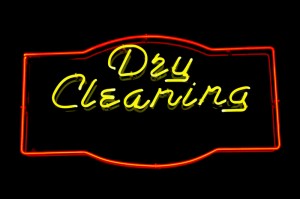Expect dry cleaners to start considering alternatives
 Taking those white shirts or suits, or delicate dresses, to the dry cleaners has been a standard routine of daily life for decades. How would we get that wine spill off of our sport coat without the neighborhood dry cleaners business?
Taking those white shirts or suits, or delicate dresses, to the dry cleaners has been a standard routine of daily life for decades. How would we get that wine spill off of our sport coat without the neighborhood dry cleaners business?
But dry cleaners are also entering the era of heightened awareness of everything “green” and, as such, are getting closer scrutiny regarding claims of “green” or “organic” dry cleaning.
There is no regulation of the dry cleaning business in regards to what qualifies them as more “green” than others, or if the term “organic” is rightfully justified.
Still, alternatives to the use of perc (perchlorol-ethylene) as a major cleaning agent are being considered. Good Housekeeping magazine recently reported that about 85 percent of dry cleaners use perc, which, while safe for the customer wearing the clothes, is strictly regulated because if it is not handled properly it can become a toxic pollutant and dangerous to those who work at a dry cleaners business.
A federal law has called for the phasing out of perc being used at dry cleaners located in residential buildings by the year 2020. With this sort of reasoning becoming more widespread, it is likely we’ll see cleaning businesses moving toward safer alternatives.
Of those, a liquid CO2 cleaning process already deemed safe by the EPA, may come into more use. Because it reuses most of its CO2, it is not considered as a dangerous greenhouse gas contributor.
A new cleanser called Green Earth, which is a liquid silicone, makes claims to degrade to sand, CO2 and water, but the EPA has to give this product further study.
Wet cleaning is always a possible alternative, but it does have those age-old problems of discoloring or shrinking some fabrics. It is likely that those in the cleaning business will come up with ways for wet cleaning to avoid some of those pitfalls.
It also is likely that dry cleaners will begin to use hydrocarbon solvents because they can easily be used in current perc machines. Because they are petroleum-based, hydrocarbon solvents must also be handled with extreme care, but the EPA views them as products that are engineered to biodegrade much faster than perc.
Consumers will certainly continue to measure the progress of dry cleaners “going green” simply on the basis of how well the alternative processes clean their clothes.
In reviews by magazines and consumer watchdogs, Green Earth has been getting praise as a good cleaner for the usual culprits – coffee, lipstick and oil stains. CO2 cleaning is generally considered the least likely to shrink your clothes, while the wet cleaners continue to struggle with that ornery lipstick, oil and ink.
Perc is generally considered the best for oil and lipstick stains, but not always reliable on ink and wine, while the perc alternative hydrocarbon has been considered the best for stains on wool products. But with cotton clothing, the hydrocarbon cleaner doesn’t fare as well.


